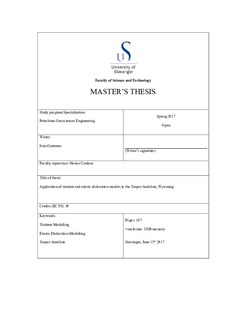| dc.contributor.advisor | Cardozo, Nestor | |
| dc.contributor.author | Gutierrez, Ivan | |
| dc.coverage.spatial | USA, Wyoming, Teapot Dome | nb_NO |
| dc.date.accessioned | 2017-11-07T10:14:57Z | |
| dc.date.available | 2017-11-07T10:14:57Z | |
| dc.date.issued | 2017-06-15 | |
| dc.identifier.uri | http://hdl.handle.net/11250/2464548 | |
| dc.description | Master's thesis in Petroleum Geosciences Engineering | nb_NO |
| dc.description.abstract | Teapot Dome is a Laramide fault-propagation fold developed over a west-vergent thrust that involves basement. In this thesis, I test the applicability of the kinematic trishear model and the mechanical elastic dislocation model to the Teapot Dome, Wyoming. The public domain dataset provided, consisting of 2D and 3D seismic, and a couple of wells with fracture data, is a typical example of a dataset with poor seismic imaging of the steeply dipping forelimb and lack of coverage in the footwall region. Additionally, the underlying thrust is not clearly imaged. Kinematic 2D trishear inverse modelling was applied to reconstruct the geometry of the thrust, forelimb and footwall on eight cross sections along the anticline. Then, a 3D structural model was constructed based on the trishear modelled cross-sections. This 3D structural model was the input for elastic dislocation modelling (ED). ED helped validating and modifying the reconstructed anticlinal and thrust geometry. ED fracture prediction was validated using fracture data from two selected wells, one close to the thrust and another in the backlimb. Fractures in these wells are tensile, and the ED predicted maximum compressive stress (S1) close to the wells, is subparallel to the wells fractures, which indicates that the ED model is a good proxy for the orientation of tensile fractures, and perhaps also shear fractures. Fracture intensity can be predicted using the ED maximum Coulomb shear stress (MCSS), which suggests more fracturing near the thrust and particularly in the footwall area. On cross section, trishear and ED proxies for fractures are similar, although the orientation of ED conjugate shear planes and trishear lines of no finite elongation (LNFE) is somewhat different, with the acute angle between LNFE being smaller than the one for the ED conjugate shear fractures. These results highlight the importance of using structural modelling techniques in discrete fracture networks (DFN) generation, and not just statistical or seismic-attributes based techniques. | nb_NO |
| dc.language.iso | eng | nb_NO |
| dc.publisher | University of Stavanger, Norway | nb_NO |
| dc.relation.ispartofseries | Masteroppgave/UIS-TN-IPT/2017; | |
| dc.subject | petroleumsteknologi | nb_NO |
| dc.subject | petroleum engineering | nb_NO |
| dc.subject | trishear modelling | nb_NO |
| dc.subject | elastic dislocation modelling | nb_NO |
| dc.subject | teapot dome | nb_NO |
| dc.subject | petroleumsgeologi | nb_NO |
| dc.title | Application of trishear and elastic dislocation models to the Teapot Anticline, Wyoming | nb_NO |
| dc.type | Master thesis | nb_NO |
| dc.subject.nsi | VDP::Teknologi: 500::Berg‑ og petroleumsfag: 510::Geoteknikk: 513 | nb_NO |
| dc.subject.nsi | VDP::Matematikk og Naturvitenskap: 400::Geofag: 450::Petroleumsgeologi og -geofysikk: 464 | nb_NO |
